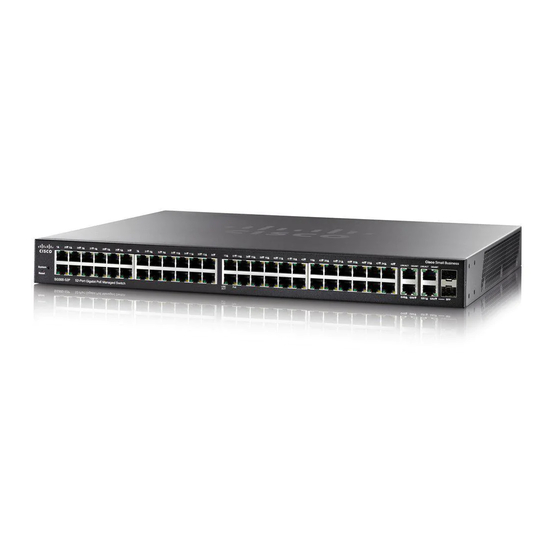
Table of Contents
Advertisement
Advertisement
Table of Contents

Summary of Contents for Cisco SG300-52P-K9-NA
- Page 1 Quick Start Guide Cisco 300 Series Managed Switches...
-
Page 2: Mounting The Cisco Switch
Welcome Thank you for choosing the Cisco 300 Series Managed Switch, a Cisco network communications device. This device is designed to be operational right out of the box as a standard bridge. In the default configuration, it will forward packets between connecting devices after power up. - Page 3 • Mechanical Overloading—The device should be level, stable, and secure to prevent it from sliding or shifting out of position. • Circuit Overloading—Adding the device to the power outlet must not overload that circuit. Cisco 300 Series Managed Switches...
-
Page 4: Rack-Mount Placement
Wall Mounting Only the 8-port models of the switch can be wall-mounted. The switch should be mounted so that the ports face up or down. Do not mount the switch with the ports to the side. Cisco 300 Series Managed Switches... -
Page 5: Connecting Network Devices
The switch should have a minimum of 5 inches (130 mm) of clearance on all sides. Insecure mounting may damage the device or cause injury. ARNING Cisco is not responsible for damages incurred by insecure wall- mounting. Connecting Network Devices To connect the switch to the network: Connect the Ethernet cable to the Ethernet port of a computer, printer, network storage, or other network device. -
Page 6: Power Over Ethernet (Poe) Considerations
Cisco strongly recommends using Cat5 or better cable for Gigabit connectivity. When you connect your network devices, do not exceed the maximum cabling distance of 100 meters (328 feet). It can take up to one minute for attached devices or the LAN to be operational after it is connected. - Page 7 PoE switch. When a device is being falsely detected as a PD, you should disconnect the device from the PoE port and power recycle the device with AC power before reconnecting its PoE ports. Cisco 300 Series Managed Switches...
- Page 8 Configuring the Cisco 300 Series Managed Switch Before You Begin Verify the managing computer requirements in the product release notes. The switch can be accessed and managed by two different methods; over your IP network using the web-based interface, or by the Command Line Interface (CLI) through the console port.
- Page 9 The Getting Started window displays. You are now ready to configure the switch. Refer to the Cisco 300 Series Managed Switch Administration Guide for further information. Use the console port...
-
Page 10: Troubleshoot Your Connection
You are now ready to configure the switch. Refer to the Cisco 300 Series Managed Switch Administration Guide for further information. If you are not using DHCP on your network, set the IP address type on the switch to Static and change the static IP address and subnet mask to match your network topology. - Page 11 Unusually long access time: Due to the standard spanning tree loop detection logic, adding new connections may take 30 to 60 seconds for the affected interfaces and/or LAN to become operational. Cisco 300 Series Managed Switches...
-
Page 12: Front Panel Ports
These ports are also commonly referred to as miniGigaBit Interface Converter (miniGBIC) ports. The term SFP will be used in this guide. • SFP ports are compatible with Cisco modules MGBT1, MGBSX1, MGBLH1, MGBLX1, MGBBX1, MFELX1, MFEFX1, MFEBX1, and MGBT1, as well as other brands of modules. -
Page 13: Front Panel Leds
The power port and console port are located on the back panel of the managed switch. Power—The Power port is where you will connect the switch to power. Depending on the model of switch you are using, this may be a power cord or a power adaptor. Cisco 300 Series Managed Switches... -
Page 14: Returning The Device To The Factory Default Settings
• To restore the managed switch configuration to the factory default settings: 1. Disconnect the managed switch from the network or disable all DHCP servers on your network. 2. With the power on, press-and-hold the Reset button for more than 10 seconds. Cisco 300 Series Managed Switches... -
Page 15: Where To Go From Here
Cisco Firmware Downloads www.cisco.com/go/smallbizfirmware Cisco Open Source www.cisco.com/go/ Requests smallbiz_opensource_request Cisco Partner Central www.cisco.com/web/partners/sell/smb (Partner Login Required) Product Documentation Cisco 300 Series Managed www.cisco.com/go/300switches Switches Regulatory, Compliance, and www.cisco.com/en/US/docs/switches/ Safety Information lan/csb_switching_general/rcsi/ Switch_RCSI.pdf Warranty Information www.cisco.com/go/warranty Cisco 300 Series Managed Switches... - Page 16 Cisco and the Cisco logo are trademarks or registered trademarks of Cisco and/or its affiliates in the U.S. and other countries. To view a list of Cisco trademarks, go to this URL: www.cisco.com/go/trademarks. Third-party trademarks mentioned are the property of their respective owners.
















Need help?
Do you have a question about the SG300-52P-K9-NA and is the answer not in the manual?
Questions and answers